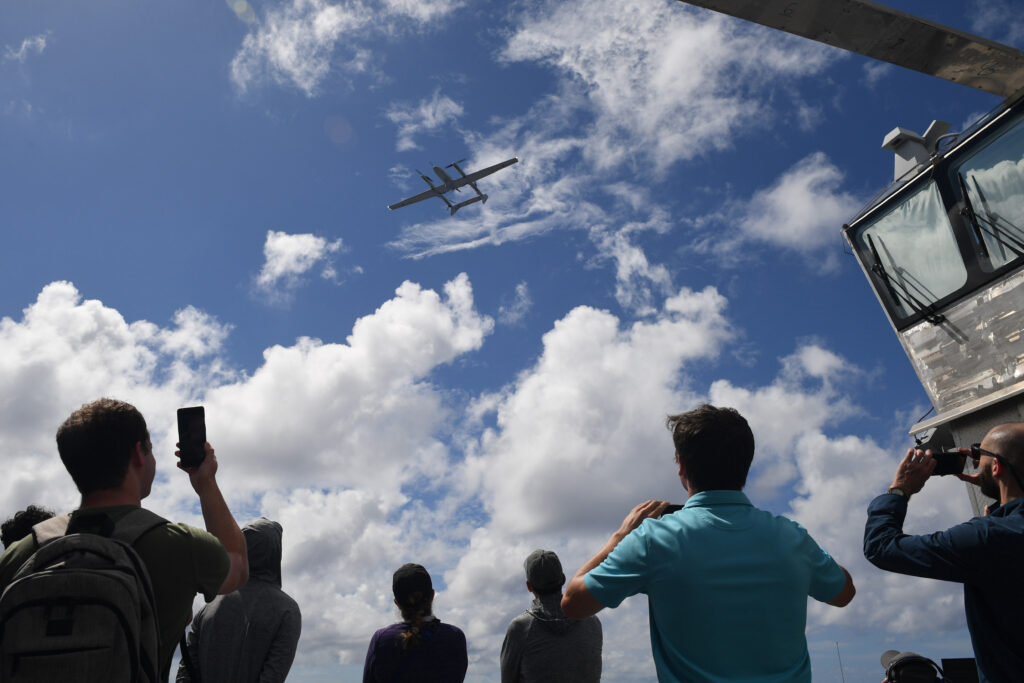
ATLANTIC OCEAN — The Navy’s Fleet Experimentation Program (FLEX), featuring unmanned aerial and surface vehicles, was held on the Spearhead-class expeditionary fast transport vessel USNS Burlington (T-EPF-10) in the waters around Key West, Fla. Oct. 16-21, 2022, U.S. Naval Forces Southern Command/U.S. 4th Fleet Public Affairs said in a Nov. 3 release.
Organized by U.S. Naval Forces Southern Command/U.S. 4th Fleet, and the Office of Naval Research’s (ONR) sponsored SCOUT initiative, the goal of FLEX was to test, evaluate and showcase the latest unmanned vehicles to strengthen and increase warfighter capabilities.
The purpose of this event is to bring new technology to address operational problems in the fleet,” said Christopher Heagney, the Naval Air Fleet and Force advisor to U.S. Naval Forces Southern Command/U.S. 4th Fleet and ONR. “Manned systems have an operational penalty of having people. The operational commander is assuming a high risk when there is a person who can be captured or killed. By having an unmanned system we are able to eliminate that.”
Heagney said Joint Interagency Task Force South (JIATF-South) only has a limited number of assets to interdict illicit trafficking in the U.S. Southern Command area of responsibility. If those assets break, they lose valuable time going back to port, getting repair parts and returning. Unmanned platforms could present a solution by transporting those parts to where they need to be at sea.
ONR’s SCOUT initiative is an ongoing, multi-agency experimentation campaign for identifying alternative ways to bring unmanned technologies to solve warfighter problems, operationalize them and bring them to the Fleet. SCOUT is committed to getting nontraditional, commercial-off-the-shelf, government-developed and/or government-sponsored technologies to the fleet rapidly.
The Key West FLEX employed commercially developed unmanned aerial systems (UAS) and unmanned surface vehicles (USV) to carry out diverse tasks related to drug interdiction including tracking and identifying specific targets, logistics and re-supply and forward-deployed combat repair. The unmanned vehicles performed re-supply maneuvers in the ocean and at inland and coastal locations.
Industry leaders agree that the ultimate goal is to lessen the danger to warfighters through the use of unmanned systems and thus enhancing their capabilities. One day these technologies such as delivery of equipment and parts, fuel, provisions and medical supplies can be vital to mission safety and success of warfighters operating in austere conditions.
“FLEX is an important and productive partnership between 4th Fleet, Center for Naval Analysis and the Office of Naval Research as well as industry partners to implement solutions to pressing operational problems,” said Rear Adm. Doug Sasse, 4th Fleet’s reserve vice commander. “Efficient flow of logistics in a contested environment is going to be a key enabler to the Navy and Marine Corps operating concepts of distributed maritime operations (DMO) and expeditionary advance-based operations (EABO), and a lot of the technology that we have incorporated as part of FLEX will help DMO and EABO reach full potential.”
ONR SCOUT, Fourth Fleet and JIATF-South worked alongside other commands including the Naval Research Laboratory, Marine Corps Warfighting Laboratory, Defense Innovation Unit and Naval Air Systems Command. ONR sponsored Scientists-to-Sea went underway with Burlington to see the technology firsthand.
“This year is quite exciting as we have been building on previous events to improve our capabilities at sea, leveraging unmanned assets in order to do what we want, and do it out at sea,” said Capt. Chip Wrye, the director of the Maritime Operations Center. “Specifically, this week we have been figuring out how to move packages between ships that are each individually moving, and do it in a way that the unmanned asset can find the receiving ship, and transfer its package to that ship without putting personnel in harm’s way.”
“FLEX and the ONR SCOUT collaboration event was a great opportunity to see the mission readiness of industrial capabilities to mitigate logistical support challenges to deep-sea operations, which drive Navy and Coast Guard ship day availability to JIATF-South,” said Jeffrey Havlicek, J7 director for Innovation and Technology, JIATF-South. “This event showcased a menu of options and generated comparative insights vital to our mission-area analysis of low-cost resupply at sea.”
The Key West FLEX event was the culmination of multiple scenario-based demonstrations of technology capabilities and characteristics held this year leading up to a large-scale main experimentation event in March 2023.
U.S. Naval Forces Southern Command/U.S. 4th Fleet supports U.S. Southern Command’s joint and combined military operations by employing maritime forces in cooperative maritime security operations to maintain access, enhance interoperability, and build enduring partnerships in order to enhance regional security and promote peace, stability and prosperity in the Caribbean, Central and South American region.
- Red Sea Update - April 26, 2024
- U.S. Begins Construction on Temporary Pier to Deliver Humanitarian Aid to Gaza - April 26, 2024
- IKE Carrier Strike Group Arrives in the Eastern Mediterranean - April 26, 2024






